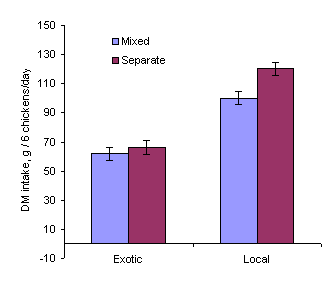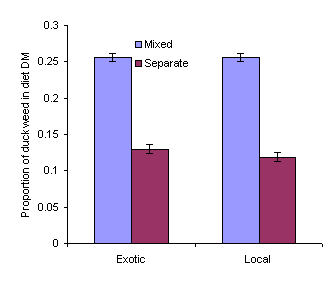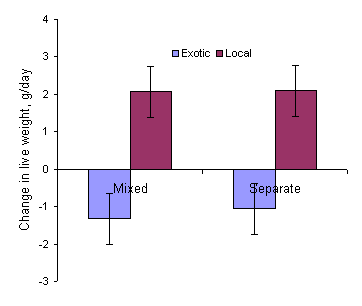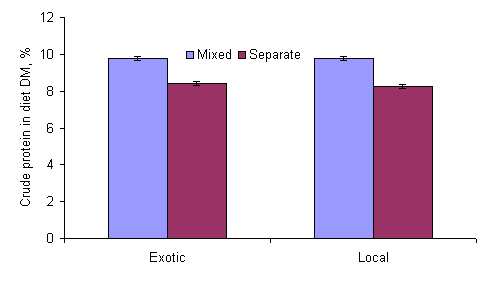Duckweed as a supplement to broken rice for local and exotic chickens
Nguyen The Thao
An Giang University
Background
It is common in many rural areas of Vietnam the use of the scavenging
strategy for chickens at village level, in order to obtain complementary protein
for diets particularly rich in energy fractions, mainly from rice. Duckweed is a highly productive water plant which is also of
high nutritive value when adequately fertilised. This plant is rich
in water-soluble vitamins and trace elements and contains a
relatively high proportion of protein unbound to cell walls, which
makes it highly suitable to be used for monogastric animal species.
When exotic breeds of poultry are taken into account, the
possibility of selecting vegetative sources of protein, such as
duckweed, may be less pronounced than when local breeds are used.
In consequence, it is assumed that a synergism could be present in local
breeds of poultry in their capacity to select duckweed as the protein source
when the basal diet is broken rice.
Hypotheses
Given the opportunity, local chickens will select and consume duckweed to a greater extent than exotic
chickens.
Objectives
Groups of local and exotic chicken will be fed on Duckweed and Broken rice, offered in separate feeders and as a mixture. The aim is to assess the capacity of local and exotic 5 weeks-old chickens to balance the “intake” of Duckweed and broken rice.
Materials and methods
Treatments and animals:
There are two sets of treatments:
-
Breed of chicken: Local or exotic
-
Feeding system: Duckweed and Broken rice in separate feeders or as a mixture
There are two replicates of each treatment (6 chickens per treatment/replication). For the mixture the proportions are 80 duckweed and 20 broken rice (fresh matter basis).
Measurements
Intake of Duckweed and Broken rice (mixture and separately), will be determined daily in the total period. Bird live weight will be determined every 5 days. Samples of water spinach and broken rice will be analyzed for DM and N. The birds are weighed every week.
Statistical analysis.
Analysis of variance using the GLM option of Minitab software will be used to analyze the data. Sources of variation are chicken ecotype (local or exotic), feeding system, interaction ecotype*feeding system, error
Results and discussion
Noteworthy features of the dietary ingredients are the low protein content of the broken rice and the low dry matter content of the duckweed (Table 1).
|
Table 1: Composition of the diet ingredients |
||
|
|
DM % |
Crude protein in DM % |
|
Broken rice |
84.7 |
6.09 |
|
Duckweed |
5.43 |
24.1 |
Data are available only for the first 15 days after which the duckweed ceased to grow. However, there appeared to be consistent effects on the feed intake showing that when the diet was composed of broken rice and duckweed given as a mixture or fed separately:
- the local chickens eat more DM than exotic chickens (Figure 1), and that local chickens consume more DM when the two ingredients are fed separately, compared with when the two are mixed together.
- about 12% of the diet DM is consumed as fresh duckweed when the chickens have opportunity to select and that the proportion selected is the same for local as for exotic chickens (Figure 2).
 |
 |
| Figure 1: DM intake by local or exotic chickens offered duckweed and broken rice separately or as a mixture | Figure 2: Proportion of the diet DM consumed as duckweed by local or exotic chickens offered duckweed and broken rice separately or as a mixture |
There were also marked differences in the growth responses between the two genotypes (Figure 3). The exotic chickens lost live weight while the local chickens gained in weight. There were no differences in growth response between chickens of either genotype when the broken rice and duckweed were given as a mixture or separately, despite the fact that the dietary protein content was lower when the ingredients were given separately rather than as a mixture (Figure 4).

Figure 3: Changes in live weight of
local and exotic chickens offered duckweed
and broken rice separately or as a mixture

Figure 4: Crude protein in diet DM
consumed by local and exotic chickens when broken rice
and duckweed were fed separately or as a mixture
References
AOAC 1990 Official Methods of Analysis. Association of
Official Analytical Chemists. 15th edition (K Helrick
editor) Arlington pp 1230
UndersanderD, Mertens D R and Thiex N 1993Forage analysis procedures. National Forage Testing Association. Omaha pp:154